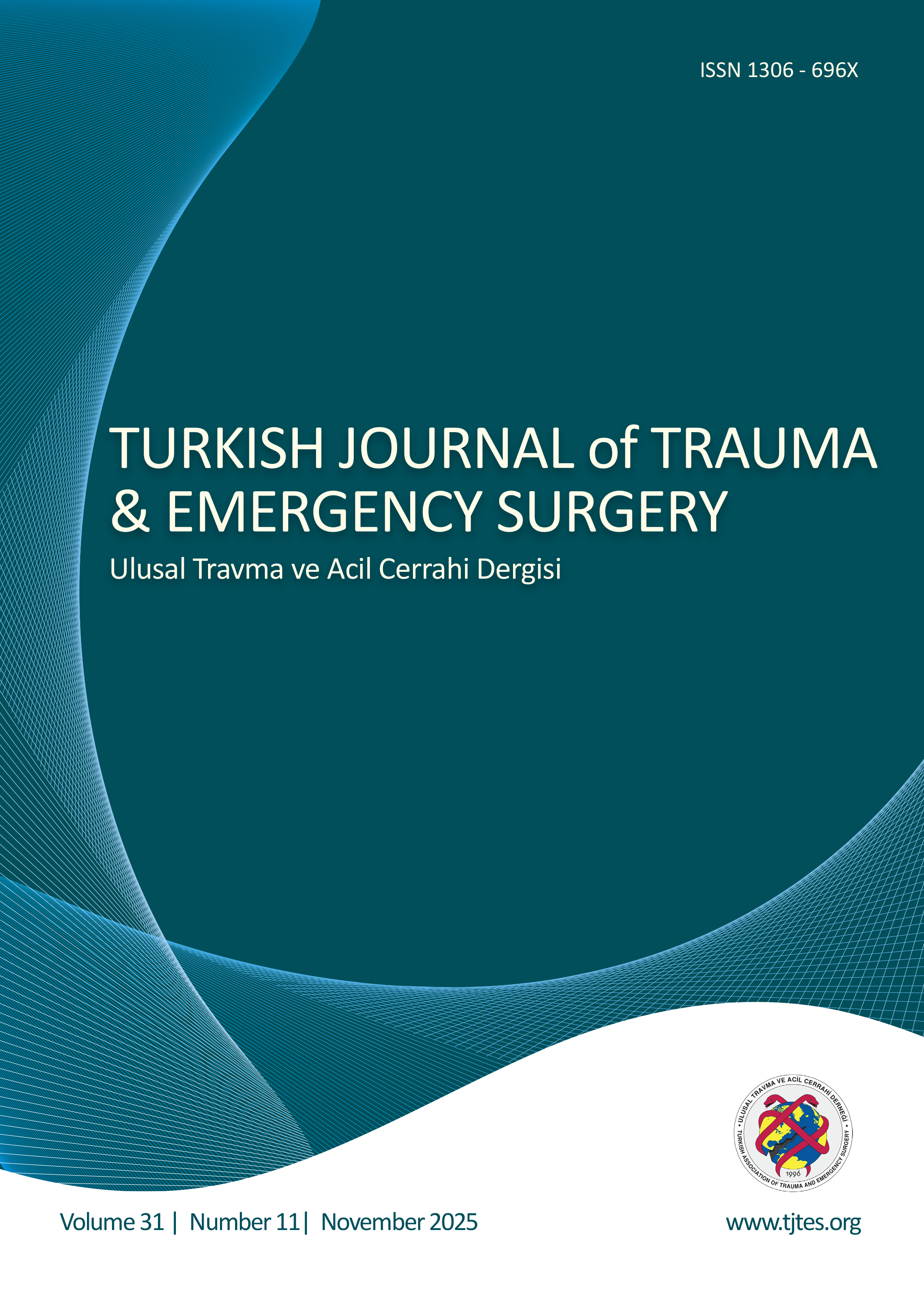Hızlı Arama
Peptik ülser perforasyonunda erken ameliyat sonrası morbidite ve mortalite belirleyicileri
Metin Yalcin1, Serdar Oter2, Alper Akınoğlu31Antalya Eğitim ve Araştırma Hastanesi, Genel Cerrahi Kliniği, Antalya2Manisa Şehir Hastanesi, Gastroenteroloji Cerrahisi Kliniği, Manisa
3Çukurova Üniversitesi Tıp Fakültesi, Genel Cerrahi Anabilim Dalı, Adana
AMAÇ: Peptik ülser perforasyonu (PUP), akut karın nedenlerinden biridir, bu durumun insidansı tüm abdominal acillerin %5idir. PUP sonrası morbidite ve mortalite için çok sayıda prognostik faktör bildirilmiştir, bu çalışma PUPlu hastalarda mortalite ve morbiditeyi etkileyen faktörleri analiz etmeye çalışmaktadır.
GEREÇ VE YÖNTEM: Ocak 2008Ocak 2018 tarihleri arasında kliniğimizde PUP nedeniyle opere edilen hastaların tıbbi kayıtları geriye dönük olarak incelendi. Bu çalışmaya toplam 318 hasta dahil edildi. Hastalar geriye dönük olarak yaş, cinsiyet, komorbidite, ASA skoru, biyokimyasal, hematolojik parametreler, komplikasyonlar ve mortalite açısından incelendi. Morbidite ve mortaliteyi etkileyen risk faktörleri de değerlendirildi. BULGULAR: Çalışma popülasyonu 318 hastadan oluşmaktaydı ve hastaların yaş ortalaması 41.30±19.37 (min-maks: 1689) idi. Çalışmada 271 (%85.22) hasta erkek, 47 (%14.78) kadın ve erkek/kadın oranı 5.76 idi. Morbidite belirteçlerinin analizinde, yaş ≥60, (p<0.001); perforasyon-cerrahi aralığı >24 saat (p<0.001); pürülan intraperitoneal kontaminasyon (p<0.001); ameliyat öncesi böbrek yetersizliği (p<0.001); duodenal perforasyon (p<0.001); ameliyat öncesi şok (p<0.001) ve ASA skoru >III (p<0.0001) istatistiksel olarak anlamlı bulundu. Cinsiyet istatistiksel olarak anlamlı bulunmadı (p=0.672). Ameliyat sonrası dönemde 318 hastanın 15inde (%4.71) mortalite gelişti. Çok değişkenli analizde yaş ≥60, (p<0.001); perforasyon-cerrahi aralığı >24 saat (p<0.001); pürülan intraperitoneal kontaminasyon (p<0.001); ameliyat öncesi böbrek yetersizliği (p<0.001); duodenal perforasyon (p<0.001) ve ameliyat öncesi şok (p<0.001) ameliyat sonrası mortalitenin bağımsız öngörücüleri olarak bulundu. TARTIŞMA: Çalışmamızda; yaş ≥60, perforasyon-ameliyat aralığı >24 saat, pürülan intraperitoneal kontaminasyon, ameliyat öncesi böbrek yetersizliği, duodenal perforasyon, ameliyat sonrası dönemde ameliyat öncesi şok ve yoğun bakım ünitesi ameliyat sonrası morbidite ve mortalitenin bağımsız öngördürücüleri olarak bulundu. Kapsamlı bir klinik değerlendirme, yeterli sıvı resüsitasyonu, uygun antibiyotik tedavisinin başlatılması ve cerrahiye erken erişim, PUPta morbidite ve mortalite riskini en aza indirebilir.
Anahtar Kelimeler: Morbidite, mortalite, peptik ülser perforasyonu; prediktör faktörler.
Early post-operative morbidity and mortality predictors in peptic ulcer perforation
Metin Yalcin1, Serdar Oter2, Alper Akınoğlu31Department of General Surgery, Antalya Training and Research Hospital, Antalya-Türkiye2Department of Gastroenterological Surgery, Manisa City Hospital, Manisa-Türkiye
3Department of General Surgery, Çukurova University Faculty of Medicine, Adana-Türkiye
BACKGROUND: Peptic ulcer perforation (PUP) is one of the cause of acute abdomen, incidence of this entity is 5% of all abdominal emergencies. Numerous prognostic factors have been reported for morbidity and mortality after PUP, this study attempts to analyze the factors affecting mortality and morbidity in patients with PUP.
METHODS: The medical record of patients who were operated for PUP in our clinic was retrospectively evaluated between January 2008 to January 2018. A total of 318 patients were included in this study. Patients were retrospectively analyzed in terms of age, gender, comorbidity, ASA score, biochemical, hematological parameters, complications, and mortality. The risk factors affected to morbidity and mortality were also evaluated.
RESULTS: The study population consisted of 318 patients and the mean age of the patients was 41.30±19.37 (min-max: 1689). In the study, 271 (85.22%) patients were male and 47 (14.78%) were female and male to female ratio was 5.76. In the analysis of the predictors of morbidity, age ≥60 years, (p<0.001); perforation-surgery interval >24 h (p<0.001); purulent intraperitoneal contamination (p<0.001); pre-operative renal failure (p<0.001); duodenal perforation (p<0.001); pre-operative shock (p<0.001); and ASA score > III (p<0.0001) were found statistically significant. Gender was not found statistically significant (p=0.672). Mortality developed in 15 (4.71%) of 318 patients in the post-operative period. In the multivariate analysis, age ≥60 years, (p<0.001); perforation-surgery interval >24 h (p<0.001); purulent intraperitoneal contamination (p<0.001); pre-operative renal failure (p<0.001); duodenal perforation (p<0.001); and pre-operative shock (p<0.001) were found to be independent predictors of post-operative mortality.
CONCLUSION: In our study, age ≥60 years, perforation-surgery interval >24 h, purulent intraperitoneal contamination, pre-oper-ative renal failure, duodenal perforation, pre-operative shock, and intensive care unit in the post-operative period were found to be independent predictors of post-operative morbidity and mortality. A comprehensive clinical evaluation, adequate fluid resuscitation, initiation of appropriate antibiotic therapy, and early access to surgery can minimize the risk of morbidity and mortality in PUP.
Keywords: Morbidity, mortality, peptic ulcer perforation; predictor factors.
Makale Dili: İngilizce





